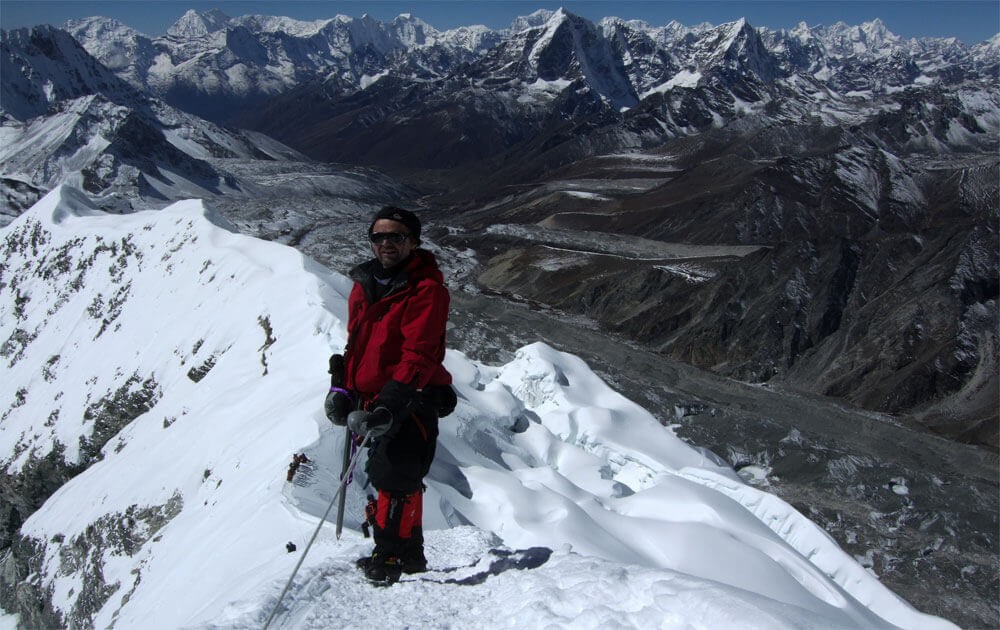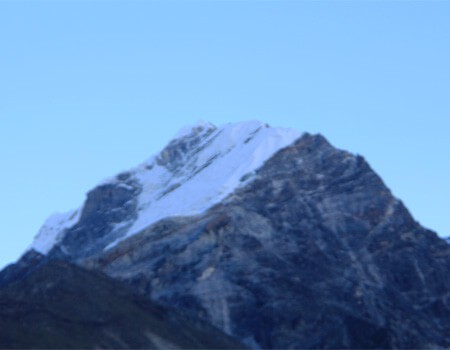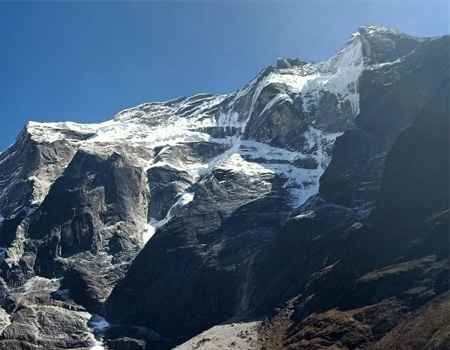Island Peak Climbing is more than just a mountain ascent; it is a journey through the heart of the world's most famous Himalayas, blending adventure, culture, and personal achievement. With the proper preparation, guidance, and determination, this expedition offers a safe and rewarding introduction to high-altitude climbing. Whether you combine it with Everest Base Camp, the Three Passes Trek, or embark on the classic route, Island Peak promises memories and views that will last a lifetime. Choose Frolic Adventure for expert support, and set your sights on one of Nepal's most iconic summits.
Island Peak, locally known as Imja Tse, is a legendary Himalayan summit that offers adventure seekers the perfect blend of trekking, technical climbing, and breathtaking mountain vistas. This comprehensive package information will guide you through every aspect of the Island Peak climbing experience, from its location and elevation to the challenges, best seasons, essential training, and why combining it with Everest Base Camp or the Everest Three Passes Trek makes for an unforgettable journey. You'll also discover why Frolic Adventure is your trusted partner for a safe and successful ascent.
Island Peak Climbing is one of Nepal's most popular mountaineering adventures, ideal for trekkers looking to transition into the world of Himalayan climbing. Rising to 6,189 meters (20,305 feet), Island Peak is nestled in the heart of the Khumbu region, surrounded by the towering giants of Everest, Lhotse, and Ama Dablam. The journey to its summit is a thrilling combination of classic trekking trails, Sherpa culture, and a technical climb that rewards you with panoramic views from the top.
The standard expedition typically follows the renowned Everest Base Camp trail, providing ample time for acclimatization and cultural immersion before tackling the peak. Along the way, climbers experience the vibrant life of Namche Bazaar, the serene monasteries of Tengboche, and the high-altitude landscapes of Dingboche and Chhukung. The final ascent involves glacier travel, fixed ropes, and a challenging headwall, making it a true mountaineering milestone.
Whether you're a novice climber with basic skills or an experienced trekker seeking your first Himalayan summit, Island Peak offers the perfect introduction to high-altitude climbing. The adventure is not just about reaching the summit; it's about the journey through the world's most iconic mountain scenery, the camaraderie of fellow climbers, and the achievement of standing atop a Himalayan peak.
Where is Island Peak Located
Island Peak is situated in the Khumbu Region of eastern Nepal's Everest Himalayas, within the boundaries of Sagarmatha National Park—a natural UNESCO World Heritage Site. Specifically, it lies in the Imja Valley, just south of the massive Lhotse Shar and east of the village of Dingboche and Chhukung. The peak is an extension of the southeast ridge of Lhotse, making it a prominent feature along the Everest Base Camp trekking route.
The coordinates for Island Peak are approximately 27.92°N, 86.94°E. The base camp is typically established at Pareshaya Gyab, at an altitude of around 5,200 meters (17,060 feet), providing a strategic starting point for summit attempts. The location is renowned for its stunning views and accessibility from the main Everest trekking trails, making it a favorite among climbers and trekkers alike.
Island Peak Elevation
Island Peak rises to an impressive elevation of 6,189 meters (20,305 feet), making it one of the most accessible yet challenging trekking peaks in Nepal. The base camp is situated at approximately 5,200 meters, with some expeditions opting for a high camp at around 5,500 meters to shorten the ascent to the summit.
The climb from base camp to the summit involves a significant elevation gain, traversing glaciers, snowfields, and rocky ridges. The high elevation requires climbers to be well-acclimatized and prepared for the effects of thin air, including the risk of Acute Mountain Sickness (AMS). Despite its classification as a "trekking peak," Island Peak's elevation and technical sections demand respect and thorough preparation.
How Hard is it to climb Island Peak
Island Peak is often described as a "moderately difficult" climb, suitable for advanced beginners and intermediate climbers with basic mountaineering skills. While it is less technical than the 8,000-meter giants, it presents several challenges that make it an actual test of endurance and skill.
Technical Difficulty
- Alpine Grade: 2B (Alpine Grading System)
- Key Challenges: Glacier travel, crevasse crossings, steep snow and ice headwall (about 100 meters), fixed rope sections, and a narrow summit ridge.
- Required Skills: Use of crampons, ice axe, harness, and fixed ropes. Familiarity with glacier travel and self-arrest techniques is essential.
Physical Demands
- Summit Day: Typically 9–12 hours round trip from base camp, involving sustained effort at high altitude.
- Terrain: Steep ascents, exposed ridges, and technical climbing sections.
- Weather: Sub-zero temperatures, high winds, and intense sunlight require proper equipment and resilience.
Acclimatization
Proper acclimatization is crucial to minimize the risk of AMS. The standard itinerary includes gradual ascent and rest days, often incorporating the Everest Base Camp trek for optimal adaptation. You will have your first acclimatization and altitude practice from Namche Bazaar to the Hotel Everest View on the third day after leaving Kathmandu, and the second rest day will be in Pheriche.
Besides the rest and altitude practice hikes, you will be acclimatized after successfully visiting Everest Base Camp (5,364m/17,598 feet) and hiking to Kala Patthar (5,550m/18,208 feet) before trekking to Island Peak Base Camp to climb. This process makes it easier to adjust to high altitudes.
Who Can Climb?
- Novice trekkers with prior trekking experience, basic mountaineering training, and guidance from experienced Sherpas.
- Experienced Trekkers who are looking to step up to technical alpine climbing.
- An adventure alpinist with patience, determination, and focus is as important as physical fitness, especially on summit day.
Best Seasons
Choosing the right season is critical for a safe and enjoyable Island Peak climbing experience. The best times to attempt the climb are spring (March to May) and autumn (September to November).
Spring (March–May)
- Stable, with milder temperatures and clear skies.
- Panoramic vistas of Everest, Lhotse, Makalu, and surrounding peaks.
- Well-established, minimal snow or ice accumulation.
- Ideal for first-timers, with lower avalanche risk and vibrant mountain scenery.
Autumn (September–November)
- Cool, dry, and stable, with excellent visibility.
- Crisp, clear mountain panoramas.
- Less crowded than spring, with firm trails and minimal precipitation.
- Preferred by those seeking quieter trails and dramatic post-monsoon landscapes.
Off-Seasons
- Winter (December–February): Extreme cold, heavy snow, and increased risk—recommended only for experienced climbers.
- Monsoon (June–August): Heavy rainfall, landslides, and poor visibility—generally avoided for safety reasons.
Training Before Summit Attempt
Preparation is the key to a successful climb of Island Peak. The expedition demands a combination of cardiovascular endurance, strength, technical skills, and mental resilience. Our climbing guide trained you on using ascenders and descenders, figure eights, and emergency procedures at the base camp. Then you will be ready to head for the summit.
Physical Training
- Cardiovascular Endurance: Running, hiking, cycling, and stair climbing to improve stamina for long days on the trail and summit push.
- Strength Training: Focus on legs, core, and upper body. Exercises like squats, lunges, planks, and deadlifts are recommended.
- Long-Distance Trekking: Practice multi-day treks with a loaded backpack to simulate the conditions of an expedition.
Technical Skills
Mountaineering Equipment: Become comfortable using crampons, an ice axe, a harness, and fixed ropes.
Glacier Travel: Practice rope techniques, crevasse rescue, and self-arrest maneuvers to ensure safe travel on glaciers.
Climbing Courses: Consider enrolling in an introductory mountaineering course or participating in guided training before the expedition.
Mental Preparation
- Resilience: Be prepared for long, challenging days and unpredictable weather.
- Focus: Stay attentive to safety protocols and guide instructions.
Everest Base Camp and Island Peak Combined
Combining the Everest Base Camp (EBC) Trekwith Island Peak climbing is a popular option that enhances acclimatization and maximizes your experience in the Himalayas.
Why Combine EBC with Island Peak?
- Acclimatization: Trekking to EBC (5,364 meters) and Kala Patthar (5,545 meters) prepares your body for the higher altitude of Island Peak.
- Scenic Diversity: Experience the legendary Khumbu Valley, Sherpa culture, and dramatic landscapes before the summit climb.
- Cultural Immersion: Visit iconic villages, monasteries, and glaciers along the route.
Permits and Costs
You must obtain a Sagarmatha National Park Permit, a Khumbu Rural Municipality Permit, and an Island Peak Climbing Permit. The climbing permit costs $250 from March to May and $125 in autumn and other seasons. At the same time, the national park entry ticket costs 3000 NPR, and the local rural municipality fee is 2000 NPR.
We arrange all required permits and food accommodations, including meals, in the guesthouses during the trek and at the tented camp at the base camp, as outlined in our package cost. We operate this adventure climbing trip to Island Peak for individual climbers and in a group. If you book this trip with two or more people at the same time, we offer a special group rate.
Clockwise Everest Three Passes Trek Before Island Peak
For the ultimate Himalayan adventure, consider the Clockwise Everest Three Passes Trek before climbing Island Peak. This route traverses three high passes—Renjo La (5,360 m), Cho La (5,420 m), and Kongma La (5,535 m)—before culminating in the Island Peak summit.
Highlights
- Three High Passes: Experience the thrill of crossing Renjo La, Cho La, and Kongma La, each offering unique perspectives of the Everest region.
- Gokyo Valley: Explore turquoise lakes, glaciers, and panoramic viewpoints.
- Everest Base Camp and Kala Patthar: Visit iconic landmarks en route to Island Peak.
- Diverse Landscapes: Trek through lush forests, arid high-altitude valleys, and glaciated terrain.
- Cultural Encounters: Immerse yourself in Sherpa hospitality and ancient traditions.
Why Go Clockwise?
- Acclimatization: Gradual ascent helps prevent altitude sickness.
- Scenic Progression: Each pass offers new and increasingly dramatic views.
- Summit Finale: Finish your trek with the ultimate challenge—climbing Island Peak.
Choose Frolic Adventure for a Safe and Successful Climb
Selecting the right operator is essential for a safe, enjoyable, and successful Island Peak climbing experience. Frolic Adventure stands out as a trusted partner, offering expert guidance, personalized service, and a commitment to your safety and satisfaction.
Why Frolic Adventure?
- Experienced Guides: Certified, English-speaking guides with extensive experience in high-altitude climbing and rescue.
- Comprehensive Support: Full logistical support, including permits, equipment, meals, and accommodation.
- Safety First: Rigorous safety protocols, regular health checks, and emergency contingency plans.
- Tailored Itineraries: Flexible programs to suit your pace, experience, and interests.
- Quality Equipment: Provision of high-quality climbing gear, tents, and safety equipment.
- Local Expertise: Deep knowledge of the Khumbu region, Sherpa culture, and mountain conditions.
- Transparent Pricing: Clear breakdown of costs with no hidden fees.
Your Success, Our Priority
Frolic Adventure's reputation is built on delivering successful summits and unforgettable Himalayan experiences. We focus on safety, preparation, and client satisfaction, ensuring that you can focus on the adventure, knowing you're in capable hands.
Equipment
Quality equipment for climbing is essential, which is why we provide regular maintenance on our equipment to ensure optimal performance. Additionally, you can hire items like helmets and crampons in Chhukung. However, please also bring your personal walking and warm clothing to wear. We also provide you with a sleeping bag and a down jacket to wear in the camps.
Views from the Summit
- The summit of Island Peak offers one of the most spectacular panoramas in the Himalayas. From the top, climbers are rewarded with:
- Towering Lhotse directly above, one of the world's most dramatic mountain walls.
- The iconic, sharply pointed peak of Ama Dablam to the southwest.
- The world's fifth-highest mountain, Makalu, is visible on clear days.
- Baruntse, Nuptse, and the Imja Valley: A sweeping vista of glaciers, ridges, and snow-capped giants.
- While Lhotse partially obscures Everest itself, the sense of proximity to the world's highest peak is palpable.
The sense of achievement and the 360-degree views from the summit are truly unforgettable—a fitting reward for the effort and determination required to reach the top of Island Peak.

















